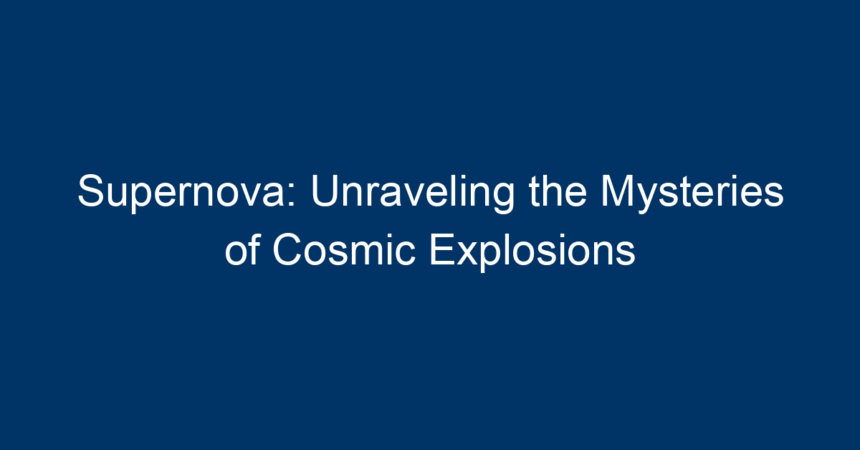The universe is an intricate tapestry of celestial wonders, and among its most awe-inspiring phenomena is the supernova. These cataclysmic explosions not only illuminate the cosmos but also play a crucial role in the life cycles of stars and the evolution of galaxies. In this article, we will dive deep into the mysteries of supernovae, exploring their classifications, the science behind their explosions, and their far-reaching impacts on the universe.
What is a Supernova?
A supernova is an astronomical explosion that occurs at the end of a star’s life cycle. When a star exhausts its nuclear fuel, its core collapses under gravity, leading to a massive and brilliant outburst. This explosive event can release as much energy in a few weeks as our Sun will generate over its entire lifetime. Supernovae can outshine entire galaxies for a brief period, offering astronomers invaluable insights into the structure and expansion of the universe.
Types of Supernovae
Supernovae are generally classified into two main types based on their mechanisms and characteristics: Type I and Type II.
Type I Supernovae
Type I supernovae occur in binary star systems, where one star is a white dwarf. When the white dwarf accumulates sufficient material from its companion star, it can reach a critical mass known as the Chandrasekhar limit (approximately 1.4 times the mass of the Sun). Once this limit is surpassed, the star undergoes a thermonuclear explosion, resulting in a Type I supernova. These events are particularly significant as they exhibit consistent brightness, making them useful as standard candles in measuring cosmic distances.
Type II Supernovae
Conversely, Type II supernovae arise from the core-collapse of massive stars (typically those above eight solar masses). When these stars exhaust their nuclear fuel, their cores compress, leading to a catastrophic implosion. The outer layers are expelled into space, creating a stunning nebula. Type II supernovae are more diverse in their brightness and spectra, providing a richer variety of data for scientists to analyze.
The Science Behind Supernovae
Understanding the mechanics of supernovae involves delving into nuclear fusion, gravitational collapse, and shock waves.
Nuclear Fusion
During a star’s life, nuclear fusion occurs in its core, where hydrogen atoms fuse to form helium, releasing tremendous energy. This process continues with the fusion of heavier elements as the star evolves, creating an outward pressure that counteracts the force of gravity. When the fuel is depleted, the balance shifts, leading to a catastrophic collapse.
Gravitational Collapse
In a supernova, if a massive star exhausts its fuel, the core will collapse under its own gravity. This process is incredibly rapid (occurring in mere seconds), leading to extreme densities and temperatures. Neutrons are formed, and the core may collapse into a neutron star or even a black hole, depending on the mass.
Shock Waves and Ejecta
The explosive force generated by the core collapse produces shock waves that travel outward, expelling the outer layers of the star at incredible velocities. The remnants are often rich in heavy elements formed during the stellar lifecycle and through nucleosynthesis during the explosion. These elements are crucial for the creation of new stars, planets, and even life itself.
The Role of Supernovae in the Cosmos
Supernovae play a pivotal role in the cosmic ecosystem. They are key contributors to the chemical enrichment of the universe and are essential for the cycle of stellar evolution.
Cosmic Chemistry
The explosion of a supernova disperses heavy elements into the surrounding interstellar medium. Elements like carbon, oxygen, iron, and magnesium are crucial for the formation of new stars and planets. Supernovae act like cosmic recycling, enriching the universe with the building blocks necessary for life.
Influence on Star Formation
The shock waves from supernovae can trigger the collapse of nearby gas clouds, leading to the formation of new stars. This chain of events enhances star formation rates in galaxies, illustrating the interconnectedness of stellar lifecycles.
Measuring the Universe
As mentioned earlier, Type I supernovae serve as standard candles due to their consistent brightness. Astronomers use them to measure distances across the universe, providing key insights into its expansion rate, known as the Hubble constant. These measurements helped shape our understanding of dark energy and the accelerating expansion of the universe.
Observations and Discoveries
Modern astronomers utilize various tools and techniques to observe and analyze supernovae. Telescopes equipped with advanced technology allow scientists to capture these fleeting events.
Space Observatories
The Hubble Space Telescope, Kepler Space Telescope, and the upcoming James Webb Space Telescope provide unprecedented views of supernovae across different wavelengths. These observatories enable detailed analysis of light curves and spectra, offering insights into the explosion mechanisms and the remnants left behind.
Citizen Science
Engaging the public in astronomical observations has also yielded remarkable results. Projects like “Supernova Discovery” allow amateur astronomers to contribute to the identification and classification of supernovae, enhancing our understanding of these cosmic phenomena.
The Future of Supernova Research
As technology advances, the study of supernovae will only deepen. Emerging telescopes and artificial intelligence tools hold promise for more efficient and accurate data analysis, potentially revealing new types of supernovae and deeper mysteries about our universe.
Impacts on Astrophysics
Understanding supernovae helps refine theories in astrophysics, cosmology, and even the potential for life beyond our solar system. It raises questions about the formation of black holes, the dynamics of galaxies, and the ultimate fate of our universe.
Conclusion: The Cosmic Symphony of Supernovae
Supernovae are among the most dramatic and transformative events in the cosmos. They serve as powerful reminders of the life cycles of stars, contributing not only to the chemical richness of the universe but also to our understanding of its vastness. As we continue to unveil the mysteries of these cosmic explosions, we further comprehend our place in the universe.
Actionable Insights
-
Stay Informed: Follow updates from space observatories and NASA for ongoing research on supernovae.
-
Engage with Astronomy: Consider joining local astronomy clubs or online forums to learn more and participate in stargazing activities.
- Explore Educational Resources: Use documentaries and books to deepen your understanding of supernovae and other astronomical phenomena.
The mysteries of supernovae are far from fully understood, but with continued exploration, we inch closer to unraveling the secrets of these cosmic explosions. As we peep further into the universe, who knows what other wonders await?




